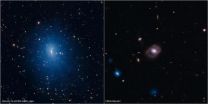(Press-News.org) The face of a doll is clearly not human; the face of a human clearly is. Telling the difference allows us to pay attention to faces that belong to living things, which are capable of interacting with us. But where is the line at which a face appears to be alive? A new study published in Psychological Science, a journal of the Association for Psychological Science, finds that a face has to be quite similar to a human face in order to appear alive, and that the cues are mainly in the eyes.
Several movies have tried and failed to generate lifelike animations of humans. For example, the lifeless faces in Polar Express made people uncomfortable because they tried to emulate life but didn't get it quite right.
"There's something fundamentally important about seeing a face and knowing that the lights are on and someone is home," says Thalia Wheatley of Dartmouth College, who cowrote the study with graduate student Christine Looser. Humans can see faces in anything—the moon, a piece of toast, two dots and a line for a nose—but we are much more discriminating when it comes to deciding what is alive and what is not.
Wheatley and Looser set out to pin down the point at which a face starts to look alive. Looser drove around New Hampshire visiting toy stores and taking pictures of dolls' faces. "It was fun trying to explain what we were doing to shopkeepers. I got some strange looks" says Looser, who then paired each doll face with a similar-looking human face and used morphing software to blend the two. This made a whole continuum of intermediate pictures that were part human, part doll.
Volunteers looked at each picture and decided which were human and which were dolls. Looser and Wheatley found that the tipping point, where people determined the faces to be alive, was about two-thirds of the way along the continuum, closer to the human side than to the doll side. Another experiment found that the eyes were the most important feature for determining life.
The results suggest that people scrutinize faces, particularly the eyes, for evidence that a face is alive. Objects with faces may look human, but telling the difference lets us reserve our social energies for faces that are capable of thinking, feeling, and interacting with us.
"I think we all seek connections with others," Wheatley says. When we recognize life in a face, she says, we think, "This is a mind I can connect with."
INFORMATION:
See examples of the morphed faces used in the experiments here:
http://www.youtube.com/user/PsychologicalScience#p/u/6/ti9o_HDAXwk
http://www.youtube.com/user/PsychologicalScience#p/u/5/X2v6Jvj7ckI
The APS journal Psychological Science is the highest ranked empirical journal in psychology. For a copy of the article "The Tipping Point of Animacy: How, When, and Where We Perceive Life in a Face" and access to other Psychological Science research findings, please contact Keri Chiodo at 202-293-9300 or kchiodo@psychologicalscience.org.
What makes a face look alive? Study says it's in the eyes
2010-12-21
ELSE PRESS RELEASES FROM THIS DATE:
Globalization burdens future generations with biological invasions
2010-12-21
A new study on biological invasions based on extensive data of alien species from 10 taxonomic groups and 28 European countries has shown that patterns of established alien species richness are more related to historical levels of socio-economic drivers than to contemporary ones. An international group of 16 researchers reported the new finding this week in the Proceedings of the National Academy of Sciences of the United States of America (PNAS). The publication resulted from the three-year project DAISIE (Delivering Alien Invasive Inventory for Europe, www.europe-aliens.org), ...
New report finds Cambodia's HIV/AIDS fight at critical crossroads in funding, prevention
2010-12-21
Phnom Penh, Cambodia (21 December, 2010) – Despite Cambodia's remarkable history in driving down HIV infections, a report released today on the future of AIDS in the country argues that future success is not guaranteed and the government needs to focus increasingly on wise prevention tactics and assume more of the financing of its AIDS program.
The report, called The Long-Run Costs and Financing of HIV/AIDS in Cambodia, written by Cambodian experts working closely with staff of the Results for Development Institute (R4D), based in Washington, D.C., finds that Cambodia, ...
How often do giant black holes become hyperactive?
2010-12-21
A new study from NASA's Chandra X-ray Observatory tells scientists how often the biggest black holes have been active over the last few billion years. This discovery clarifies how supermassive black holes grow and could have implications for how the giant black hole at the center of the Milky Way will behave in the future.
Most galaxies, including our own, are thought to contain supermassive black holes at their centers, with masses ranging from millions to billions of times the mass of the Sun. For reasons not entirely understood, astronomers have found that these ...
New study upends thinking about how liver disease develops
2010-12-21
In the latest of a series of related papers, researchers at the University of California, San Diego School of Medicine, with colleagues in Austria and elsewhere, present a new and more definitive explanation of how fibrotic cells form, multiply and eventually destroy the human liver, resulting in cirrhosis. In doing so, the findings upend the standing of a long-presumed marker for multiple fibrotic diseases and reveal the existence of a previously unknown kind of inflammatory white blood cell.
The results are published in this week's early online edition of the Proceedings ...
UCSB scientists demonstrate biomagnification of nanomaterials in simple food chain
2010-12-21
(Santa Barbara, Calif.) –– An interdisciplinary team of researchers at UC Santa Barbara has produced a groundbreaking study of how nanoparticles are able to biomagnify in a simple microbial food chain.
"This was a simple scientific curiosity," said Patricia Holden, professor in UCSB's Bren School of Environmental Science & Management and the corresponding author of the study, published in an early online edition of the journal Nature Nanotechnology. "But it is also of great importance to this new field of looking at the interface of nanotechnology and the environment."
Holden's ...
New imaging advance illuminates immune response in breathing lung
2010-12-21
Fast-moving objects create blurry images in photography, and the same challenge exists when scientists observe cellular interactions within tissues constantly in motion, such as the breathing lung. In a recent UCSF-led study in mice, researchers developed a method to stabilize living lung tissue for imaging without disrupting the normal function of the organ. The method allowed the team to observe, for the first time, both the live interaction of living cells in the context of their environment and the unfolding of events in the immune response to lung injury.
The finding ...
Strange new twist: Berkeley researchers discover Möbius symmetry in metamaterials
2010-12-21
Möbius symmetry, the topological phenomenon that yields a
half-twisted strip with two surfaces but only one side, has been a source of fascination since its discovery in 1858 by German mathematician August Möbius. As artist M.C. Escher so vividly demonstrated in his "parade of ants," it is possible to traverse the "inside" and "outside" surfaces of a Möbius strip without crossing over an edge. For years, scientists have been searching for an example of Möbius symmetry in natural materials without any success. Now a team of scientists has discovered Möbius symmetry in ...
New study examines immunity in emerging species of a major mosquito carrer of malaria
2010-12-21
In notable back-to-back papers appearing in the prestigioous journal Science in October, teams of researchers, one led by Nora Besansky, a professor of biological sciences and a member of the Eck Institute for Global Health at the University of Notre Dame, provided evidence that Anopheles gambiae, which is one of the major mosquito carriers of the malaria parasite in Sub-Saharan Africa, is evolving into two separate species with different traits.
Another significant study appearing in this week's edition of the Proceedings of the National Academy of Sciences (PNAS) and ...
New study focuses on nitrogen in waterways as cause of nitrous oxide in the atmosphere
2010-12-21
Jake Beaulieu, a postdoctoral researcher the Environmental Protection Agency in Cincinnati, Ohio, who earned his doctorate at the University of Notre Dame, and Jennifer Tank, Galla Professor of Biological Sciences at the University, are lead authors of new paper demonstrating that streams and rivers receiving nitrogen inputs from urban and agricultural land uses are a significant source of nitrous oxide to the atmosphere.
Nitrous oxide is a potent greenhouse gas that contributes to climate change and the loss of the protective ozone layer. Nitrogen loading to river networks ...
The orange in your stocking: researchers squeezing out maximum health benefits
2010-12-21
VIDEO:
BYU nutritionist Tory Parker talks about his study into why oranges are so good for you.
Click here for more information.
Provo, Utah - In time for Christmas, BYU nutritionists are squeezing all the healthy compounds out of oranges to find just the right mixture responsible for their age-old health benefits.
The popular stocking stuffer is known for its vitamin C and blood-protecting antioxidants, but researchers wanted to learn why a whole orange is better for ...





